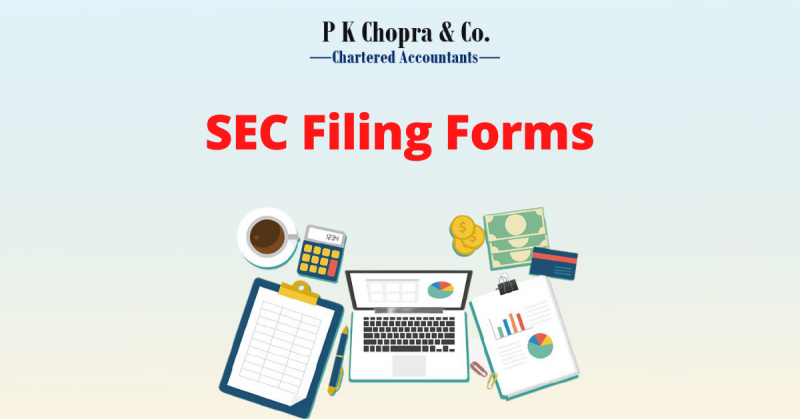SEC Filing Forms
The Securities and Exchange Commission (SEC) of the United States is a federal government watchdog that was founded during the Great Depression. Its purpose is to promote transparency and create reliable information in order to protect investors, the market, and everyone else interested in securities.
The SEC is also responsible for enforcing securities laws and prosecuting insider trading, dishonesty, and fraud offences. Filing with the SEC is just one aspect of their plan to make the market more transparent. They require that financial statements and other papers be prepared and returned to the agency by various parties.
Except for some forms, the documents are then made public via the Electronic Data Gathering, Analysis, and Retrieval System (EDGAR). The goal is to provide investors and shareholders with all of the information they require to make the best decisions possible.
What are the most common forms of filings with the Securities and Exchange Commission (SEC) in the United States?
If you are a serious investor or financial professional, understanding and analysing various SEC documents/filings will assist you in making informed investment selections. By law, publicly traded corporations must disclose relevant information about their business operations and structure.The most common types of SEC filings are:
- Form 10-K SEC Filings
Form 10-K is a detailed financial analysis report. It contains a detailed summary of the company’s results, as well as management discussions and audited financial statements. Form 10-K is also referred to as “the K.” The deadlines for filing Form 10-K vary based on the size of the company. Companies with $700 million in freely transferable shares (shares released to the public and accessible for trading) must file a 10-K within 60 days after the end of their fiscal year, according to the SEC. Companies with free floats of $75 million to $700 million, for example, have 75 days, whereas those with less than $75 million get 90 days. - SEC Filings Form 10-Q
The company’s quarterly results are reported on Form 10-Q, which is a shortened form of Form 10-K. The form will be submitted 45 days after the conclusion of each of the company’s first three fiscal years. This form outlines the company’s most recent developments as well as its future plans. It also includes unaudited financial statements that are less thorough than Form 10-K. - SEC Filings Form 8-K
Unplanned events that are important to shareholders, investors, and the SEC are reported on Form 8-K. Director resignations, bankruptcy, asset disposal, the hiring of new executives, and other significant occurrences are examples of these events. The list also provides more detailed information about these events, such as press releases and data tables. - SEC Filings Form S-1
When a company goes public for the first time, Form S-1 is the initial registration form that must be sent to investors. A prospectus is another name for a prospectus. Because there is so little public information on the company in the early days of its listing, this form is critical. The anticipated use of cash, the amount of shares to be issued, the company’s business model, competition, offering/issue price techniques, and risk concerns are all included. - SEC Filings Form F-1
It’s the same as Form S-1, but it’s for overseas corporations. - Form S-3, SEC Filings
As a “shelf registration statement,” Form S-3 is employed. It keeps track of a specific amount of equity or debt securities that can be sold to the general public at a later time. - SEC Filing Form S-4
Companies that have approved an exchange offer must file the SEC Form S-4, which contains critical information about the merger or acquisition. As a result, organisations that file SEC Form S-4 must disclose material facts about their financial and operational activities. - Sec Filing Form S-8
The employee stock option plan’s securities are recorded on Form S-8 (ESOP). Employees and the board of directors of most publicly traded companies will be given stock options or restricted stock units (BOD). For the recipient of these options or units to sell the underlying shares when exercised, the shares must be registered. - SEC Filing Forms 3, 4 and 5
Certain persons (e.g., officials, directors, and those who own more than 10% of a company’s stock are collectively referred to as “insiders”) are required by federal securities law to record acquisitions, sales, and holdings of the company’s stock by completing Forms 3, 4, and 5.
- Form 3
A firm insider or substantial shareholder must file Form 3 with the SEC and give information on the form in order for the holdings of directors, officials, and beneficial owners of registered corporations to be disclosed and become public records. - Form 4
When there is a major change in the holdings of company insiders, Form 4 must be filed with the SEC. - Form 5
SEC Form 5 must be filed by the Company insiders if they had conducted security transactions during the year but failed to report them via SEC Form 4.
Reading many documents and forms can be difficult. But if you’re a potential or current investor, it’s worth it. Once you look at the form a few times, it’s not that bad. Documents filed with the SEC provide important information and allow for transparency. Ultimately, knowing about fraud and bankruptcy can save you thousands of dollars. Fortunately, the EDGAR and FINRA database resources make it less painful. If you’re on the other side and have to submit, it can still feel like a burden.

